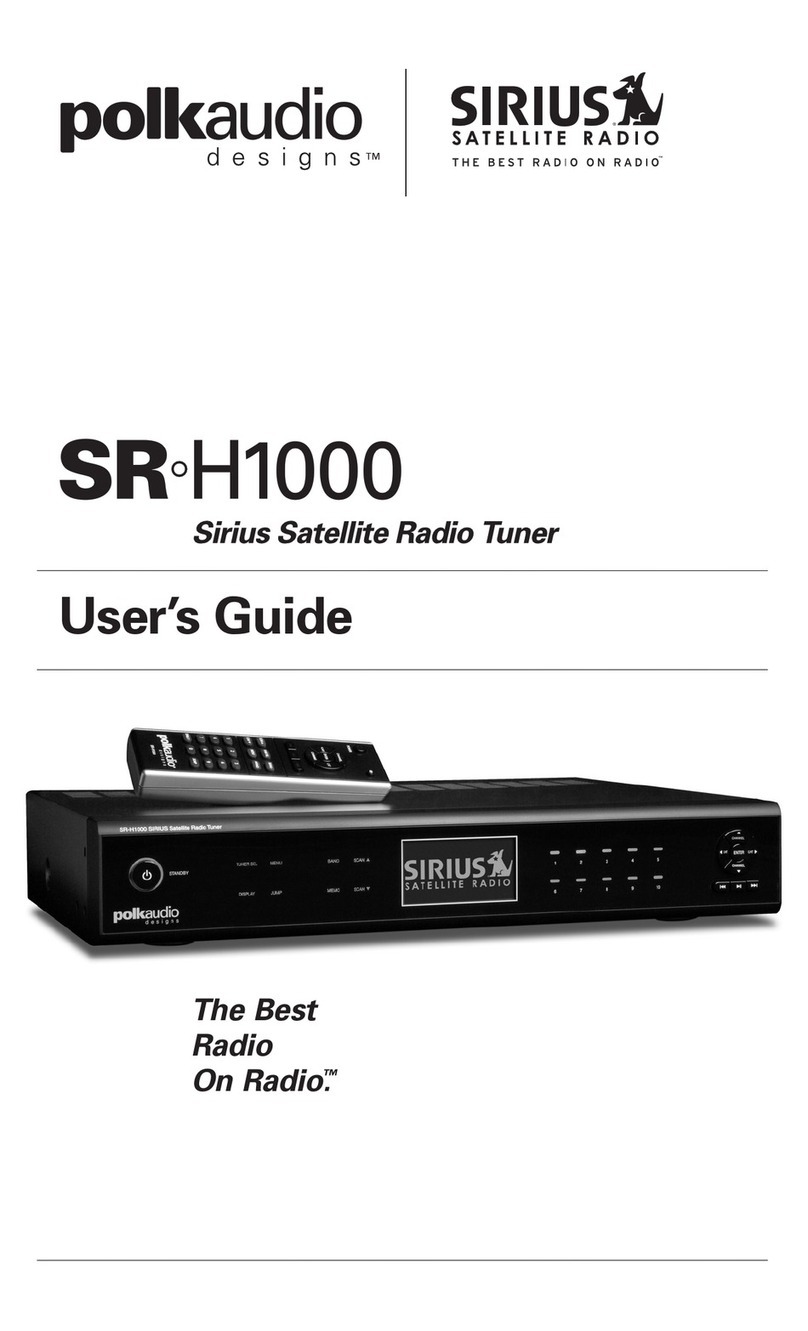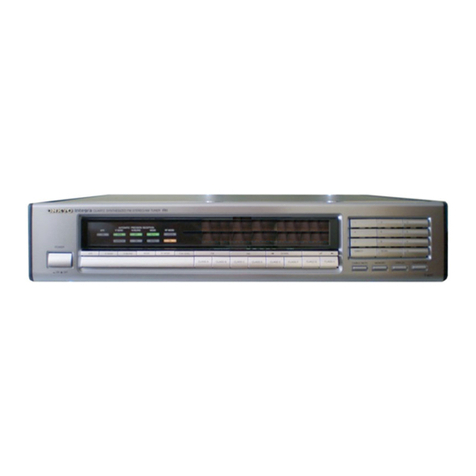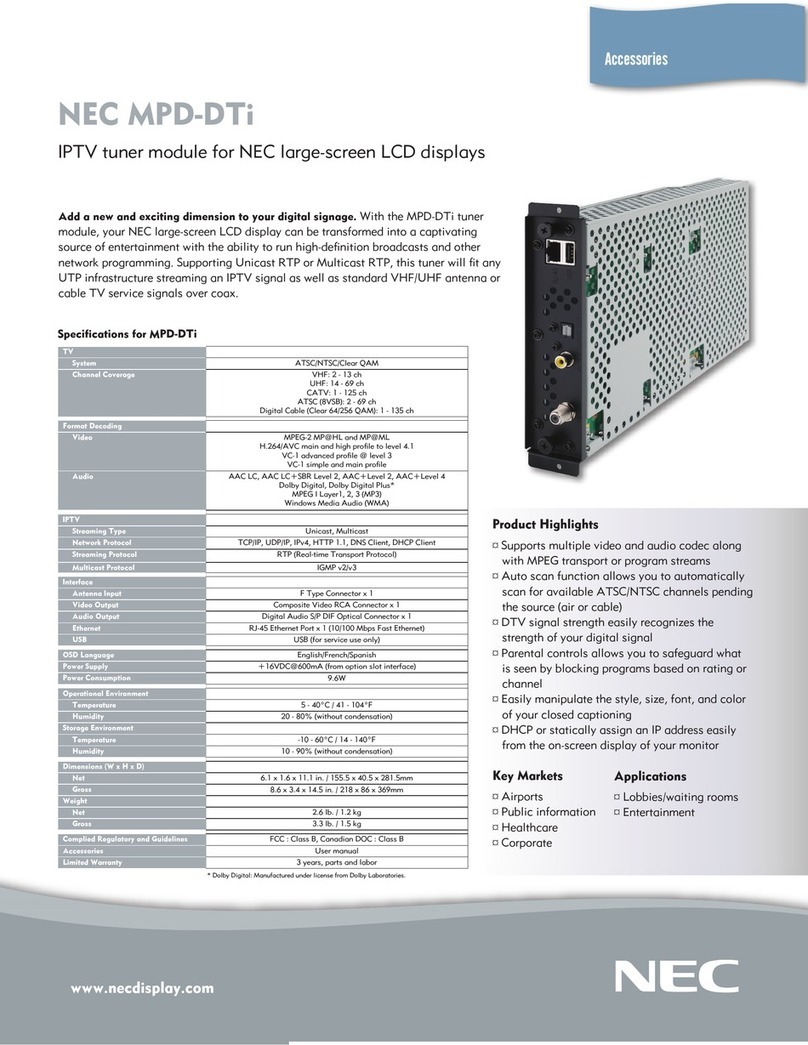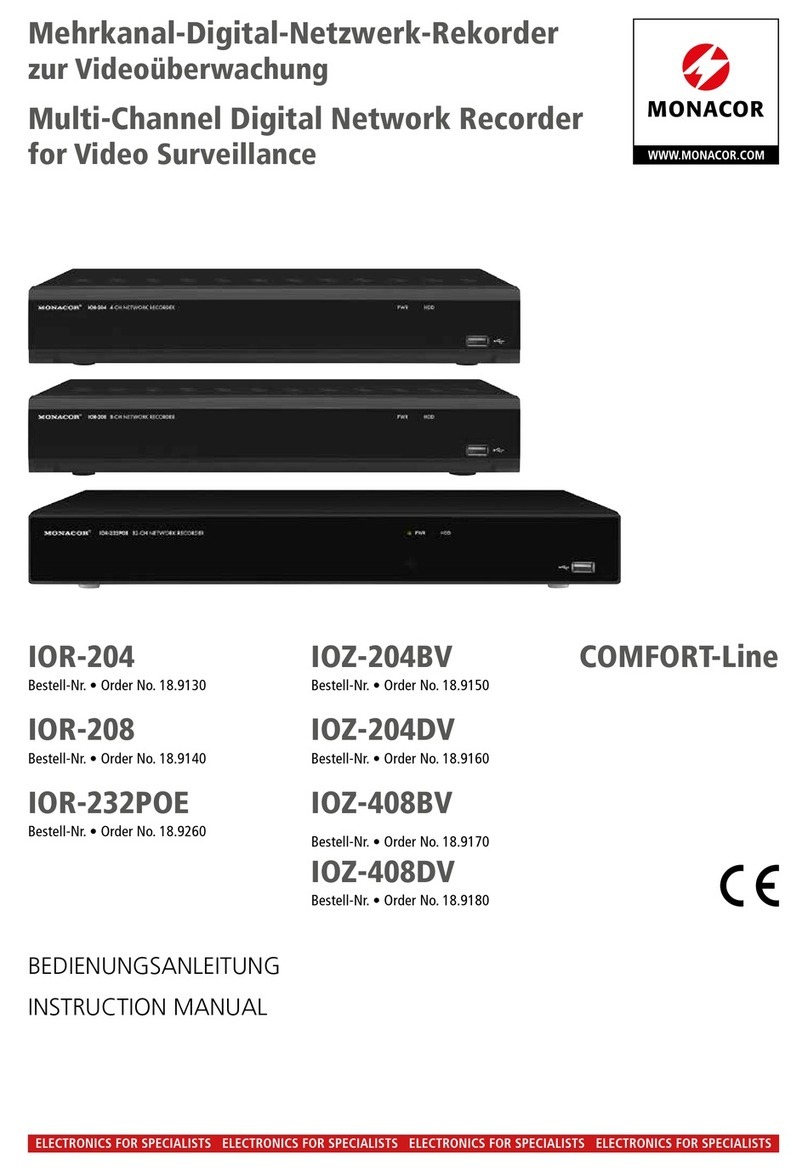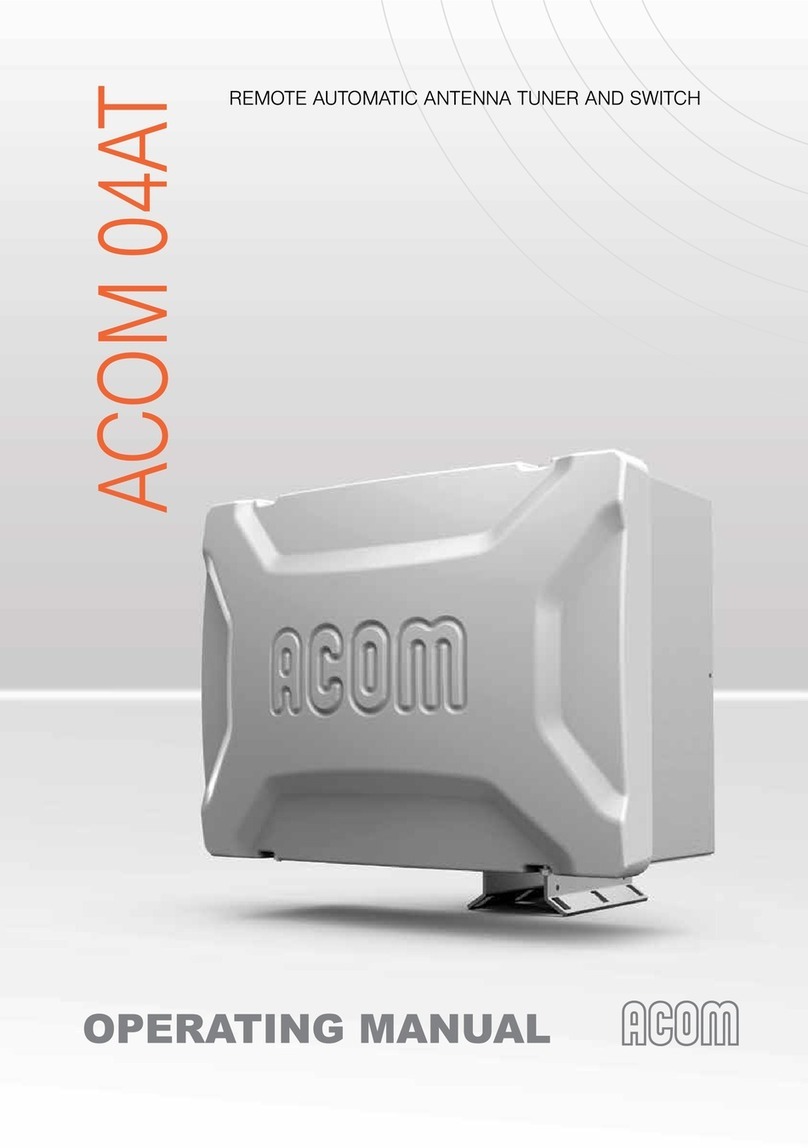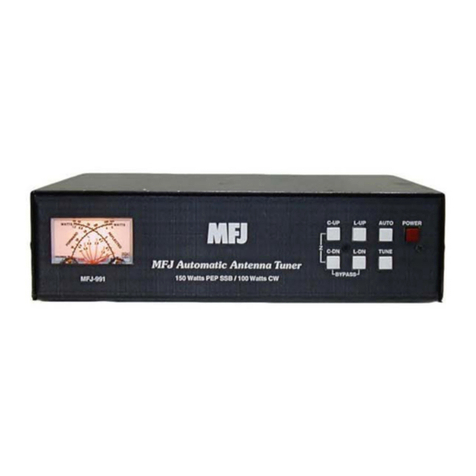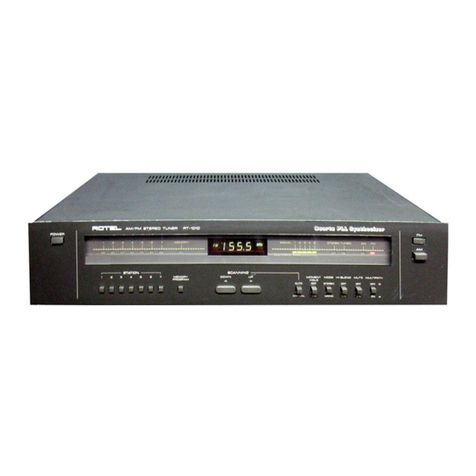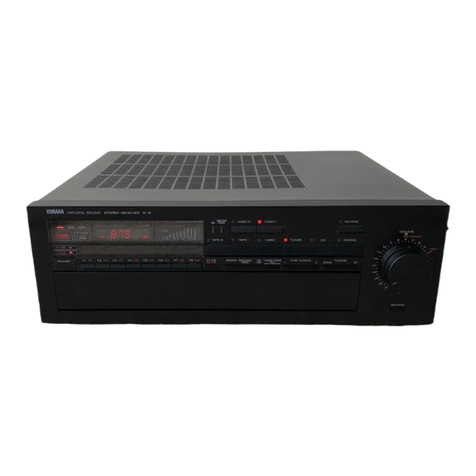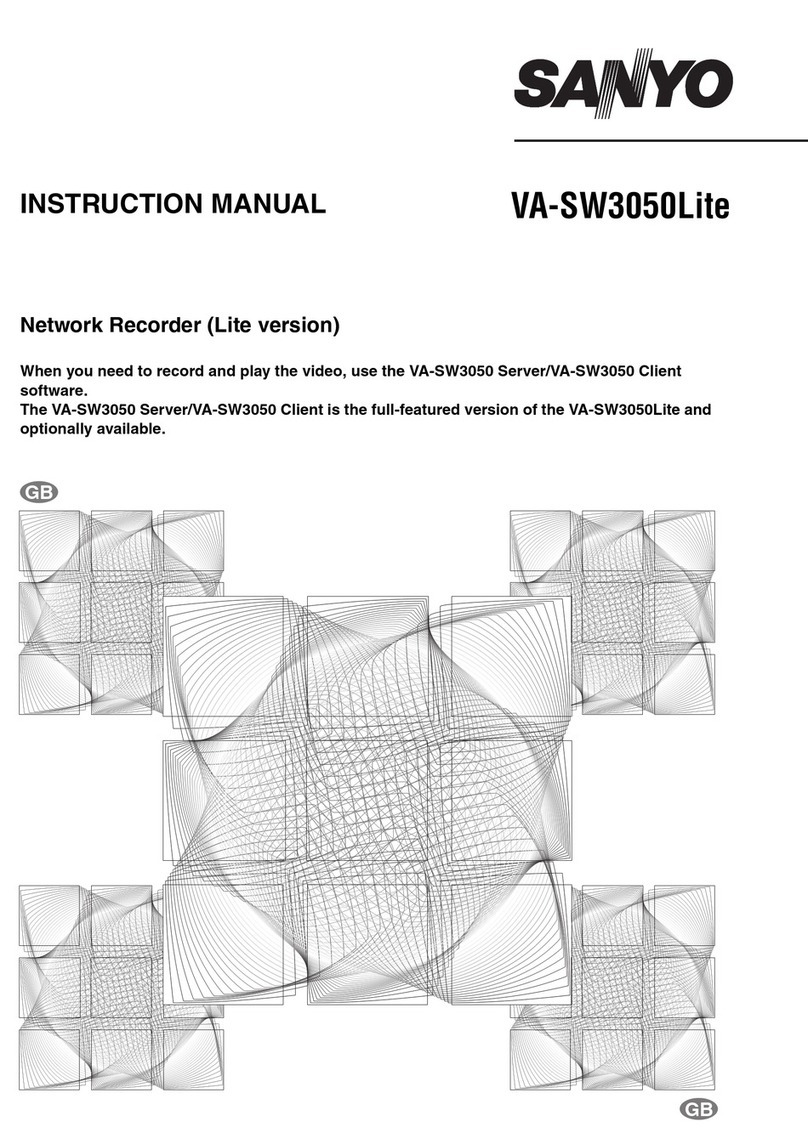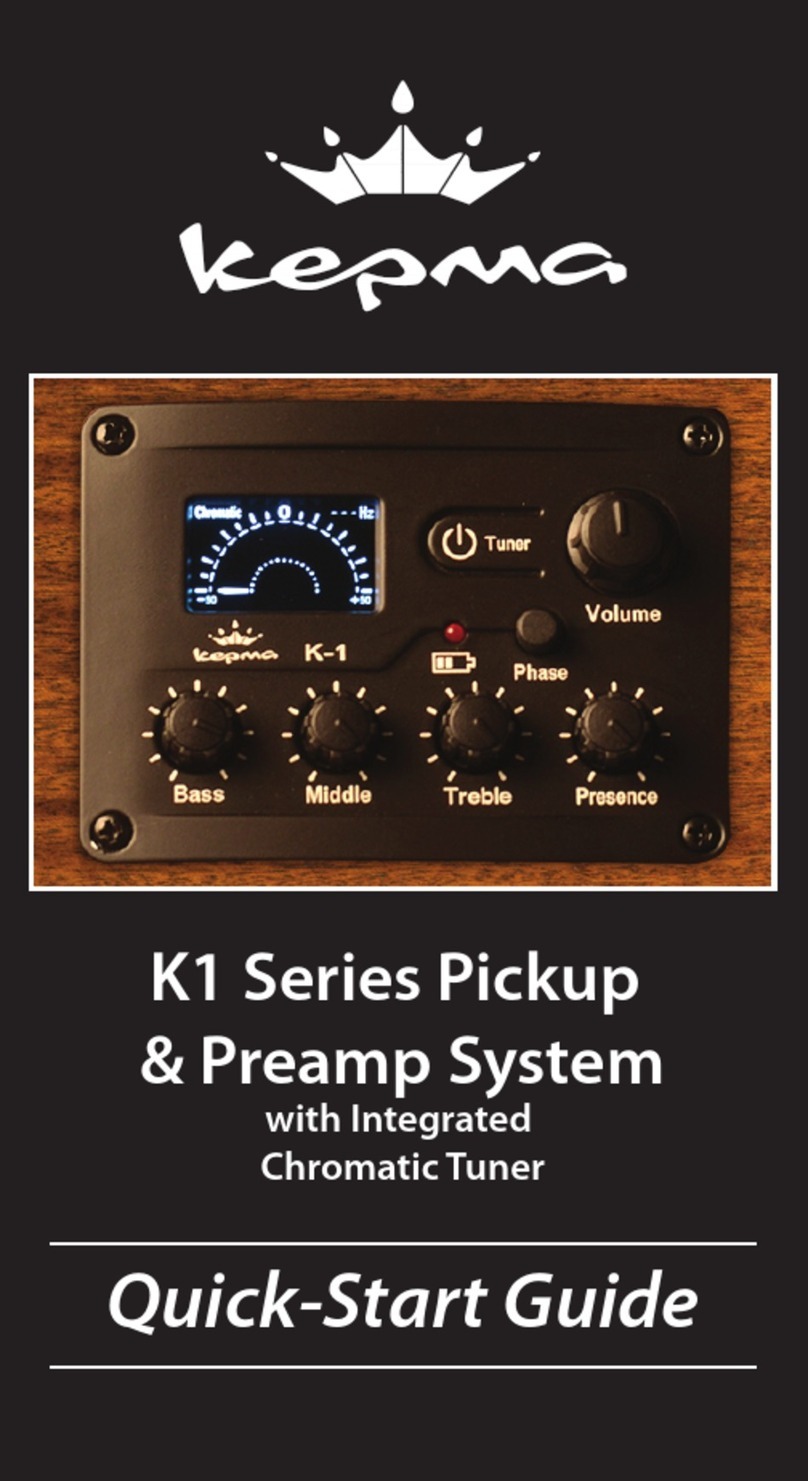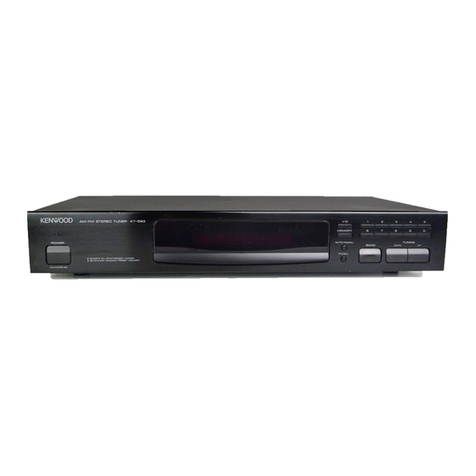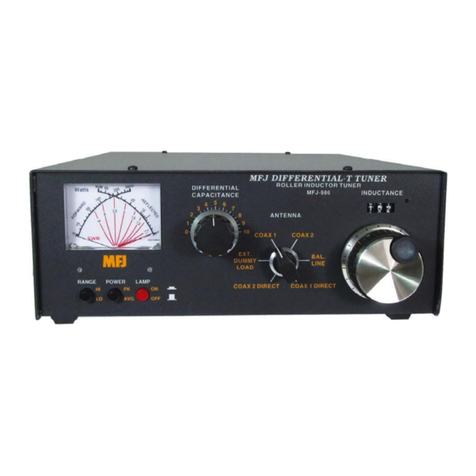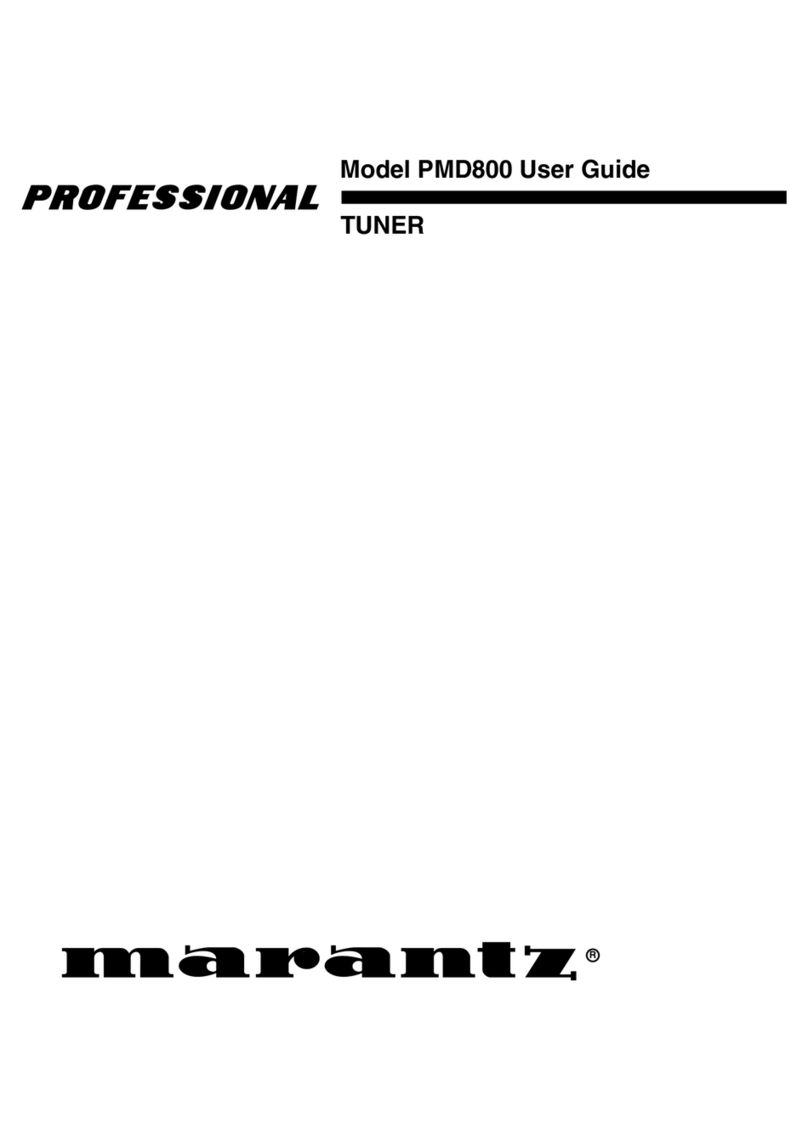ACOUSTIC SOLUTIONS CDAB-1 User manual


Page 1
Congratulations on purchasing the Acoustic Solutions
CDAB-1 DAB/FM Tuner
We trust that this product will give you hours of listening pleasure, and
provide years of unparalleled performance. As with any new electrical
product please be patient and allow 36 hours of use before all components
have acclimatized themselves with your surroundings and found their
optimum working temperature.
Please read these instructions before you operate the unit
Manufacturer of this unit follows a principle of constant improvement and is
not held responsible for any changes that are made to the unit nor accepts
any liabilities for these changes. Thanks for your choice of our products.
CONTENTS PAGE No.
Introduction
What is DAB
Safety Instructions
Front Panel Controls
Rear Panel Connections
Remote Control Functions
Installation and Position
Fixing the Antenna
Using the DAB Tuner
Using the FM Tuner
Troubleshooting
Care & Maintenance
Specications
Contact Details
DAB Digital Audio Broadcasting
DLS Dynamic Label Segment
DRC Dynamic Range Control
LED Light Emitting Diode
MMI Man Machine Interface
RDI Receiver Data Interface
SNR Signal to Noise Ratio
RDS Radio Data System
GLOSSARY
CDAB-1 DAB/FM TUNER
1
2
3
4-5
5
6
7
8
9-12
12-13
14
14
15
15

Page 2
Digital Radio is like analogue FM radio but even better. Digital radio offers
an abundance of new digital only stations, improved sound quality, no
frequencies to remember as stations are displayed using names, which
makes it very easy to tune. The audio quality of DAB is near that of a CD
with no interference and no retuning, and the introduction of text, data and
even pictures will enhance DAB in the future.
The BBC was the pioneer of digital radio, beginning transmissions in
September 1995. Digital One, the national commercial radio multiplex
operator began broadcasting in November 1999. There has been a growth
in the number of digital radio stations throughout the UK and both the BBC
and Digital One are committed to extending their coverage. Digital One
currently covers 80% of the UK population, soon to increase to 85%, and
the BBC covers 65% with the aim of increasing coverage to 80% by 2003.
To nd out about digital radio coverage in the UK, check out the following
websites:
BBC: www.bbc.co.uk/digitalradio
National Commercial Radio: www.ukdigitalradio.com
DRDB: www.drdb.org
Your Acoustic Solutions’ CDAB-1 DAB & FM tuner will receive programs
broadcast on Band 3 digital radio (174-240MHz), there are 41 channels
within this range numbered 5A to 13F, the number of channels you can
receive will be dependant on your location and signal strength. The UK has
been allocated seven multiplexes by the Radio Authority - in the spectrum
217.5-230.0 MHz, which are numbered 11B to 12D.
A multiplex is a broadcaster such as BBC or Digital One who will provide a
host of different stations within their multiplex. If we consider the BBC as an
example, the following diagram shows how the BBC multiplex may work.
The multiplex name is BBC (also sometimes referred to as an ensemble).
Also shown is channel and carrier frequency although it is not necessary to
know this as the BBC is known by name rather than frequency.
Below the main multiplex provider name will be a host of primary stations.
These are labelled as the station name again rather than the frequency.
This allows you to tune CDAB-1 by station name, which is easier than trying
to recall frequencies.
Sometimes a secondary service station may be provided by the
broadcaster, for instance this is sometimes used when an alternative
commentary is provided on a sporting match or event. These secondary
service stations are not permanent and may not always be used for
broadcast. When a secondary station is available below the primary station,
the following symbol will be shown on the display of the CDAB-1.
Details on how to use the CDAB-1 are covered in the following pages.
WHAT IS DAB?

Page 3
CAUTION: To reduce the risk of electric shock, do not remove any cover.
NO USER-SERVICEABLE PARTS INSIDE, REFER ANY SERVICING TO
QUALIFIED SERVICE PERSONNEL.
IMPORTANT SAFETY INSTRUCTIONS
• Read and keep these instructions available for future reference.
• For indoor use only.
• The unit must only be connected to a suitable mains power supply using
the mains power lead provided.
• To reduce the risk of re or electrical shock, do not expose this unit to rain
or moisture.
• The apparatus shall not be exposed to dripping or splashing.
• No objects lled with liquids, such as vases, shall be placed on the
apparatus.
• Unplug the unit from the wall socket during lightning storms and when it is
not going to be used for a long period of time.
• Take care that foreign objects do not enter, or liquids are not spilled, into
the enclosure through any openings. If this should happen, refer to
qualied service personnel before attempting to use.
• Ensure adequate ventilation - do not cover this unit with curtains, etc.
• Do not install near any heat source, such as radiators, or other equipment
that produces heat.
• Protect the mains power cable from being damaged.
• The CDAB-1 system is double insulated and does not require an earth
connection in the UK mains plug.
UK MAINS PLUG DETAILS
For your convenience a mains plug with a fuse (3 Amp) has been itted to
this appliance. For your safety please observe the following information.
• The CDAB-1 is designed to operate on AC mains supply between 220
and 240 volts, 50 Hz.
• The wires in the mains lead are coloured in accordance with the
following code:
BLUE - NEUTRAL
BROWN - LIVE
• Under no circumstances should the Neutral or Live wires be connected
to the ‘E’ (Earth) terminal.
CAUTION
RISK OF ELECTRIC SHOCK!
DO NOT OPEN!
SAFETY INSTRUCTIONS
The lightning ash symbol with the arrowhead within an equilateral triangle is
intended to alert the user to the presence of uninsulated ‘dangerous voltage’
within the product’s enclosure that may be sufcient to constitute a risk of
electric shock to persons
The exclamation point within an equilateral triangle is intended to alert the
user to important operating and maintenance instructions in the service lit-
erature relevant to this appliance.
This product complies with European low voltage (2006/95/EC)
and electromagnetic compatibility (2004/108/EC) directives.
WEEE marking
“Information for the consumer”
Disposal of your old product
Your product is designed and manufactured with high quality materials and components,
which can be recycled and reused.
When this crossed out wheeled bin symbol is attached to a product it means the
product is covered by the European Directive 2004/108/EC.
Please make yourself aware of the local collection system for electrical and
electronic products.
Please act according to your local rules and do not dispose of your old products with
your normal household waste. The correct disposal of your old product will help prevent
potential negative consequences for the environment and human health.

Page 4
Power
Press to select
Control
Headphone DAB/FM Autotune Info
0 10
Preset Station +
Preset Station -
Stereo / Mono
1 2 3 4 5 6 7 8 9
10
11 12 13 14
FRONT PANEL CONTROLS
1. POWER BUTTON. Switches mains power on/off, however please note
that mains power is still applied to this unit even though this switch may be
off.
2. ROTARY CONTROL KNOB. Allows adjustment of parameters such as:
In DAB mode: Turn clock wise to scroll up through station list. Turn
anticlockwise to scroll down through station list. Press once to select a
station required, Turn clockwise or anticlockwise then press and hold to
change auto enter function (see page 10)
In FM mode: Turn clock wise to scroll up through frequencies, turn
anticlockwise to scroll down through frequencies. Press once to change
audio mode: Auto, this will automatically detect between stereo and mono
broadcasts, press again to activate mono mode, this will play all broadcasts
in mono only.
3. HEADPHONE SOCKET. Stereo 3.5mm jack suitable for use with most
headphones
4. HEADPHONE VOLUME CONTROL
5. DAB/FM SELECTOR BUTTON. Press this to switch between DAB digital
radio and FM analogue radio. The LCD panel will display in the top right
hand corner ‘FM’ when in FM mode.
6. AUTO TUNE BUTTON,
In DAB mode: Press to activate an auto location of all available DAB
services. Press once for UK services, the LCD will display ‘Scan Services
Quick scan’ or hold for longer than 2 seconds to activate a full search
across entire band 3 operation, the LCD will display ‘Scan Services Full
scan’. It is not necessary to operate a full scan in the UK.
In FM mode: Press once to activate a ‘seek’ up through FM frequencies
to nd the next available station. Press and hold to activate a ‘seek’ down
through FM frequencies to nd the next available station.
7. INFO BUTTON,
In DAB mode. This changes what information is displayed on line 2 of the
LCD display. The default setting will show DLS (dynamic label segment, info
text supplied by each radio station), continue to press to show the following;
Signal strength (bar graph indication of signal strength see page 8),
program type (classication supplied by radio station ie: Pop music, Rock

Page 5
REAR PANEL CONNECTIONS
FRONT PANEL CONTROLS
music, varied speech etc), Stereo/Mono and bit rate of broadcast, Multiplex
name (name of multiplex broadcaster), time & date. Please note that this
information is supplied by the broadcaster and may not always be present.
In FM mode. This changes what information is displayed on line 2 of the
LCD display. The default setting will show the Program Station name
continue to press to show the following; time & date, RDS (radio data
system, info text supplied by each radio station), program type (classication
supplied by radio station ie: Pop music, Rock music, varied speech etc),
stereo/mono (auto) or mono mode selection (see rotary control knob).
Please note that some of this information is supplied by the
broadcaster and may not always be present.
8. PRESET Down. Button toggles presets downwards ie: 5-4-3.
9. STEREO/MONO. Switches between Stereo & Mono output (FM only)
10. PRESET up. Button toggles presets upwards ie: 3-4-5.
Power
Press to select
Control
Headphone DAB/FM Autotune Info
0 10
Preset Station +
Preset Station -
Stereo / Mono
1 2 3 4 5 6 7 8 9
10
11 12 13 14
11. ANALOGUE AUDIO OUTPUTS. For connection to line input sockets on
ampliers.
12. ANTENNA CONNECTION.
13. MAINS CABLE INLET POSITION. Please ensure that this cable strain
relief bush is intact and has not been damaged.
14. WARNING/WEEE LABELS. Please observe that this unit contains high
voltages, and should not be opened, please refer to page 3 of this manual.

Page 6
Phono Tape
DAB MP3-in
CD DVD
Auto Tune- Enter
Mono/Stereo Tune+ Info
4 5 6
1 2 3
FunctionON/Stby
DAB/FMON/Stby
VOL-
L R
VOL+
Mute
BASS
TREBLE
+ +
- -
on- LOUD -off
15
16
17
18
19
20
21
22
A remote conrol is supplied with the CDAB-1 unit, this remote is shared
between the CDAB-1 and the CAMP1 ( DAB/FM Tuner ) with the DAB
controls on the top half of the remote ( as shown ).
15. DAB/FM ON/STANDBY. Use this button to turn the unit on ( from standby
), when the unit is on press to put into standby.
16. PRESETS 1-6. Use these buttons to store up to 6 preset stations each
for DAB & FM radio.
17. MONO/STEREO. Switches between Mono & Stereo output ( FM only )
18. AUTO. Pressing this button activates Auto tune.
19. DAB/FM. Use this button to swicth between DAB radio & FM.
20. INFO. THis button cycles through the various information assigned to the
DAB or FM station you are tuned to.
21. ENTER. Press this button to select a function
22. TUNE + / -. These buttons are used to tune up or down.
REMOTE CONTROL FUNCTIONS

Page 7
INSTALLATION AND POSITION
This tuner should be positioned on a at stable surface. We would
recommend that the position of your hi- equipment should be chosen
carefully to provide adequate protection for this device, and also provide an
attractive showcase for your investment. Hi- equipment is not designed for
continuous movement, therefore it is recommended that a permanent home
for your hi- be achieved as soon as possible.
This tuner is tted with a mains transformer, it is not recommended that
sensitive audio equipment such as turntables or cassette decks be placed
immediately next to this item. Do not place this product in areas where
direct sunlight is present, nor place it adjacent to a radiator or other heating
appliances.
Like all electrical devices this tuner will generate a modest amount of heat.
The cooling of this device is reliant upon the ow of air within the case. Care
should be taken not to cover this unit with such items as rugs, covers or
curtains which will restrict this air ow and may cause over heating.
Never allow the tuner to come into contact with water or liquids, and ensure
that small objects do not fall through the ventilation grills. In the event of this
happening, disconnect the wall plug form the mains supply immediately, and
contact your local dealer for service advice.
Do not position the power cable such that it can be walked upon, or
damaged by regular trafc. Ensure that all other interconnect cables are
stowed safely behind the unit, and cannot be easily snagged or kicked thus
causing possible damage to the unit.
Ensure that all interconnection cables have been made correctly, and that
polarity has been maintained.
MAKING THE CONNECTIONS
It is necessary to connect this DAB tuner to an external amplier and
loudspeaker set up, (It is not possible to connect loudspeakers directly to
this DAB tuner). It is possible to listen to the DAB tuner without external
amplication equipment, through headphones only. Please see the following
diagrams which detail required connections:
Speaker Right
Impedance 4-16Ω
Speaker Right
Impedance 4-16Ω
Speaker Left
Impedance 4-16Ω
Speaker Left
Impedance 4-16Ω
Line Out
Line Out
L
R
L
R
DAB DVD CD Tape
L
R
L
R
Phono
DABDVDCDTapePhono
CDAB-1
INSERT HEADPHONES INTO SOCKET
ON THE FRONT OF THE DAB TUNER
HI-FI AMPLIFIER CAMP-1
POWER
SUPPLY

Page 8
FIXING THE ANTENNA
As with any radio receiver, the quality of the output signal will be directly
determined by the strength of the input signal that it receives.
Obviously the location of the tuner in relation to the transmitter will have a
direct inuence on the quality of the available signal, however it is important
to provide the best possible antenna to the tuner to provide the best signal
conditions possible.
We have provided with this DAB tuner a simple wire antenna which is
designed for internal use. Please see the following diagram for correct
installation procedure:
CDAB-1
ANTENNA ADVICE
It is possible to display the signal strength as a bar graph on the LCD
display by pressing the info button several times, this will show the following
window:
The signal strength is determined by the number of bars which are
illuminated towards the right , the stronger the signal, the more bars that will
be lled.
It is possible to adjust the signal strength by changing the position of the
antenna, and by using the visual bar graph display it is possible to position
the antenna for maximum signal strength.
Further enhancements can be made to the reception quality by purchasing
a better quality aerial, available from most hi- retailers. For best reception,
we would recommend an external or loft mounted DAB/FM antenna. There
are two main types available, a) Dipole, b) 4-element aerial.
DIPOLE
For use in marginal signal areas, this type of antenna is omnidirectional and
should increase the strength of all DAB stations being received.
4-ELEMENT AERIAL
Also for use in marginal or poor signal areas. This type is directional and
has a high gain. Like a TV or FM aerial, this type of antenna needs to point
at a transmitter. Installation requires someone to move the aerial whilst
you monitor the signal strength. If you can receive signals from multiple
transmitters you should point your aerial at the one which gives you the best
signal for the services which you want to listen to.
It is possible to use a TV or FM aerial with your DAB tuner as this is
normally mounted externally. This may give a stronger signal than a simple
internal aerial, however it would not be tuned specically for DAB reception.
You would need to change the plug on your TV/FM aerial to an ‘F’ type
connector, and it may also be necessary to use a signal booster to enhance
the signal.

Page 9
USING THE DAB TUNER
The display will read searching and you will see a moving bargragh on line
1 which indicates the progression of this tuning operation. As this process
completes numbers will be shown in the top right hand corner of the display
showing the DAB channels scanned.
If no services are located, please check that the antenna connection is
correct. It is possible to attempt to tune the CDAB-1 manually if no stations
are found after an autoscan.
To enter manual tune mode press and hold the info button to enter a
secondary menu. The rst option will be displayed as manual tune, press
the rotary control knob to activate manual tune procedure. Use the rotary
control knob to scroll through channels, the LCD screen will show the
channel number and allocated frequency. From this position press the rotary
control knob to manually tune to the channel displayed on the LCD, the
CDAB-1 will tune to the station on this channel if it is available.
Following manual tuning, if no DAB radio stations can be received, please
check that adequate DAB coverage exists in your area (see page 2 on
checking for coverage information).
GETTING STARTED
When you unpack the tuner from the box, all settings will be at default
values. These can be altered according to your listening tastes; new
settings will be retained within the memory of the tuner and will remain set
even after switching the system off.
Once you have made all the necessary connections to the DAB tuner, you
are now ready to start listening to the DAB radio experience.
When you turn on the tuner, the display will show the following message for
4 seconds:
WELCOME TO
DIGITAL RADIO
Scan Services
Full Scan
10D
20%
Following this the tuner will then enter the auto scan mode as the DAB tuner
locates digital radio stations within your area.
It is not possible to interrupt this sequence as the tuner needs to have at
least one digital station to build a station list, and it will continue to scan until
at least one service has been located.

Page 10
STATION LISTS
Following the initial autotune upon power up, the CDAB-1 will build a station
list of services that exist in your area.
The default way in which these stations will be displayed on the LCD panel
is in alphanumeric order, recognising numbers before letters, therefore
stations such as 6 Music from the BBC will be listed rst.
To change which station you are listening to, simply turn the rotary rotary
control knob clockwise to scan up through the alphabetical stations list, or
anticlockwise to scan down.
As you scroll up or down through the DAB stations stored in the memory
of the tuner, the LCD will display the name of the program on Line 1 of the
LCD, with the name of the multiplex displayed on line 2 of the LCD display.
To select a new station from the scrolling list, push the rotary control knob to
make your selection. (Note it is only necessary to press this button once to
make your selection). The DAB station will change to your new selection.
NOTE: you are able to activate an auto enter feature. This will allow the
DAB tuner to retune the DAB station automatically when you stop scrolling
through the stations without having to press the rotary control knob to
conrm your selection. This feature can be convenient, to activate press and
hold in the rotary control knob. The LCD display will read ’Auto enter ON’,
this will now activate this feature. To turn this feature off, again press and
hold the rotary control knob, the LCD will display ’Auto enter OFF’.
Once the CDAB-1 has built a station list, it will retain this list in memory
unless you decide to reset it. Sometimes it may be the case that a particular
DAB station is not available in your area, however the station still exists
in the memory of the CDAB-1. This may occur if the DAB tuner has been
moved, and is now being operated in a different location. It may also be
that secondary level DAB stations (as described on page 2 ) are not being
broadcast, thus leaving this channel inoperative.
If you decide to select this station, the display will read ‘Station not available’
and will revert back to the previous service.
SYSTEM RESET
In order to clear the station list from the memory of the unit you will need to
run a system reset and activate a quick scan.
Press and hold the info button to access a secondary menu.
Press the info button again to scroll through 2nd level option.
To select a system reset, press the rotary control knob to activate this
procedure. The CDAB-1 will commence a quick scan after the factory reset to
re establish the station list.
USING THE DAB TUNER

Page 11
SETTING PRESETS
The CDAB-1 is tted with 6 preset buttons on the remote which can store
DAB stations of your choice for one-button recall operation.
Please note that if you decide to store a secondary level DAB station, there
is a possibility that this station will only be broadcast periodically, and may
not have station content when you return to this preset in the future. If this
is the case the LCD display will read ‘Station not available’, and it will be
necessary to retune to an alternative station.
To store a preset:
1. Tune the CDAB-1 to the station required.
2. Decide which preset you want to store this station on.
3. Hold down the preset button on the remote for a few seconds.
4. LCD display will read ‘Preset saved’
If a preset does not have a station allocated to it, the LCD will read
‘Preset XX Free’ if this button is pressed.
CHANGING THE INFO SETTINGS
It is possible to change the information which is displayed on line 2 of
the LCD display when listening to a DAB station. Press the info button
repeatedly to scroll through different options.
The options are as follows;
A. DLS: Dynamic Label Segment, this is scrolling text information supplied
by the radio station. This may be information on music titles or details
regarding the program or station, and is provided by the broadcaster.
B. Signal bargraph indicator.
C. Date and time: This will display a constant time/date signal provided by
the broadcaster, this is not an internal clock and should always be accurate.
D. Program type: this is a description of the type of broadcast provided by
the radio station, e.g.: Pop music or Rock music. This is also provided by the
broadcaster.
Press Info
Press Info
Press Info
Press Info
Press Info
Station Name
DLS
Station Name
Signal
Station Name
Genre
Station Name
Stereo J 160Kbps
Station Name
Multiplex
Station Name
09:21 24-10-2006
USING THE DAB TUNER
E. Stereo/ mono status and broadcast bitrate
F. Multiplex name: this will show the multiplex which is broadcasting the
program you are listening to.

Page 12
AUTOTUNE FEATURES
The nature of DAB radio means that service line ups are changing
constantly as more secondary order stations become available.
If you are happy listening to your chosen radio stations, there may never be
the need to establish if any new primary or secondary stations have become
available.
It is possible to instigate returning of your CDAB-1 tuner to redene the
service list of stations in your area.
To do this simply press the Autotune button, this will activate a local search
for stations on band 3 in the UK only. As band 3 contains channels not
allocated to the UK, to include a process to scan for all of these would
only add unnecessary time to this function. A search in the UK should
take approximately 20 seconds. If your CDAB-1 is being used in an area
operating on band 3 outside of the UK, then the available channels can be
scanned by holding down the Autotune button for a period longer than 2
seconds. This search will take approximately 60 seconds but will build a
station list including these other band 3 channels.
USING THE FM TUNER
GETTING STARTED
To switch to FM mode, press the DAB/FM button once.
The LCD display will show:
In FM mode the ‘FM’ letters will be displayed in top right hand corner of LCD
display. The Line 1 of the LCD display will show the frequency of the station.
Line 2 of the display will show RDS data or other information as described
below:
DAB > FM
MANUAL TUNING
Using the rotary control knob turn it clockwise to step up through the
frequencies. These will step at 0.05MHz steps.
Turn it anti clockwise to step down through the frequencies. These will step
at 0.05MHz steps.
AUTO STEREO/MONO AND MONO ONLY MODE
Using the rotary control knob, press once to change between Auto and
mono modes. Press again to toggle between Auto (stereo/mono) and mono
modes.
When in auto mode the tuner will determine if the broadcast is in stereo and
switch on stereo operation respectively. When mono operation is selected,
all broadcasts will be played in mono regardless if they are originally
broadcast in stereo.
It is often necessary to play FM stations in mono to reduce the separation
effect of stereo, which can add background noise in areas with poor signal
strengths.
THE AUTO TUNE BUTTON.
It is possible to ‘seek’ through FM frequencies to nd the next available
station.
Press the Autotune button once to activate a seek ‘up’ to the next available
station.
Hold the Autotune button down to activate a seek ‘down’ to the next
available station.
USING THE DAB TUNER

Page 13
THE INFO BUTTON.
It is possible to change the information which is being displayed on line 2 of
the LCD display when in FM mode.
The options are:
A. Station name, this information is provided by the broadcaster and may
not always be available
B. Stereo / mono selection. This displays the selected mono or auto stereo/
mono setting. For information on how to alter this setting see page 12.
To change these info settings press the info button repeatedly.
C. RDS radio text, this is scrolling text supplied by the radio station. This
may be information on music titles or details regarding the program or
station, and is provided by the broadcaster.
D. Program type: this is the description of the type of broadcast provided
by the radio station eg. Pop music, Rock music, varied speech etc. This
information is provided by the broadcaster.
E. Time & date: This will display a constant time and date signal provided by
the broadcaster, this is not an internal clock and should always be accurate.
CHANGING THE PRESETS
The CDAB-1 is tted with 6 preset buttons which can store FM stations of
your choice for one button recall operation.
To store a FM preset:
When in FM mode
1. Tune the CDAB-1 to the desired station
2. Decide which preset you want to store this station on
3. Hold down this preset for longer than 2 seconds
4. LCD will display ‘Preset XX Saved’
When pressing a preset which does not contain a stored station, the LCD
will display ’Preset XX Free’.
LISTENING WITH HEADPHONES
The CDAB-1 has been tted with a headphone amplier to allow discreet
listening. Plug a 3.5mm stereo headphone jack in to the socket (3) provided.
Adjust the volume of the headphones using the headphone volume knob
(4). Turn clockwise to increase the volume in your headphones, and
anticlockwise to decrease.
The headphones amplier works independently from the output sockets on
the rear of the CDAB-1. Connecting the headphones does not disconnect
the main output signal. The headphone level control does not affect the
output level of the main output sockets.
USING THE FM TUNER

Page 14
TROUBLE SHOOTING
PROBLEM POSSIBLE SOLUTION
I cant get any sound
from my CDAB-1
Connection leads to amplier not made
correctly.
Speakers not connected to amplier.
Power of CDAB-1 or connected amplier not
turned on.
Ensure that the CDAB-1 has been able to
locate DAB stations
Display says ‘Signal N/A’ Check that antenna is connected.
Ensure that DAB coverage exists in your area.
I can’t access second-
ary services
At the time of publishing this manual not
many secondary services are available, this
will increase as more DAB stations start
broadcasting. If a secondary service station
is available, the secondary indicator >> will be
displayed next to the station name.
Display has gone blank
or says ‘Signal N/A’
This may occur if a broadcaster changes the
label of a service or removes a label whilst
you are listening to it. The CDAB-1 will try to
retune to this station, or alternatively follow the
procedure for auto tune on page 12.
PROBLEM POSSIBLE SOLUTION
I can’t hear the station I
have selected
Ensure you have pressed the rotary control
knob when you have made your selection.
I hear a burbling sound
on some stations
The station you are currently listening to will
be displayed on line 1 of the LCD display,
as you scroll through the station order list
line 2 will show other station options. Press
the rotary control knob to activate your
choice. DAB like other digital media is good
at producing quality audio from a low level
signal, however if this signal level is too low a
‘burbling’ sound can sometimes be heard. To
reduce this try repositioning your antenna to
gain maximum signal strength, alternatively
you may wish to purchase an antenna booster
to enhance the level available to the CDAB-1.
CARE AND MAINTENANCE
To clean the CDAB-1 tuner, wipe the case with a slightly moist, lint-free
cloth. Do not use any cleaning uids containing alcohol, ammonia or
abrasives. Do not spray an aerosol at or near the tuner.
Always use original packaging if it is necessary to transport the unit at any
time.
If this unit is used in a dusty environment, it may be necessary to have
the unit serviced at your local dealer periodically. It is not advisable to
allow large deposits of dust to accumulate within the unit as it may prevent
adequate cooling. Similarly dust deposits which become damp can
sometimes lead to electrical problems which may cause severe damage to
the delicate electronics within this unit.
We hope you have many years of enjoyment from the CDAB-1 system,
however if you are having any difculties please follow the trouble shooting
guide below or contact the Acoustic Solutions' helpline on 0871 2307747.
This helpline is manned from 9:00am to 1:00pm and 2:00pm to 4:30pm,
Monday to Friday.

Page 15
SPECIFICATIONS
CONTACT DETAILS
DAB FM
RF SECTION • Band III, 174MHz-
240MHz
• Input: 50R
• Max signal: 0dBm
typical
• Sensitivity: -96dBm
typical
• Adjacent Channel
Rejection: 34dB
typical
• Band III, 87.5MHz
108MHz
• Sensitivity: < 3uV
typical
DISPLAY
• 2 line by 16 character LCD
• LED backlight
PRESETS 6 6
AUDIO OUTPUT • Stereo, 730mV RMS
• 48kHz sample rate
• 16 bit sample
resolution
• SNR 75dB typical
• Stereo/Mono, 640mV RMS
• SNR 53dB typical
POWER • 230-240V AC, 20W
OPERATING TEMP • 0 to 50 deg C
We trust you are completely satised with this product from Clarity Vision
(Group) Limited, however please feel free to contact us if you experience
any difculties, or if you would like to express your views regarding our
products. Please write to:
Clarity Vision (Group) Ltd.
Grand Union Buildings
54 High Street
Weedon Bec
Northampton
NN7 4QD
United Kingdom
Telephone: 0871 230 7747 | email: enquiries@clarityvision.co.uk
Through the process of continuous improvement, Clarity Vision (Group)
Limited reserves the right to change or alter specications without prior
notice. E&OE
OTHER USEFUL ADDRESSES
BBC Digital Radio Digital Radio Development Bureau
Room 5661 The Radio Centre
Broadcasting House 77 Shaftesbury Avenue
Portland Place London
London, W1A 1AA W1D 5DU
Tel 08700 100 123 Tel 020 7306 2630
email: digitalradio@bbc.co.uk email: info@drdb.org
www.bbc.co.uk/digitalradio www.drdb.org
Digital One
20 Southampton Street
London
WC2E 7QH
W1D 5DU
Tel 020 7288 4600
email: info@digitalone.co.uk
www.digitalradio.com
Table of contents


